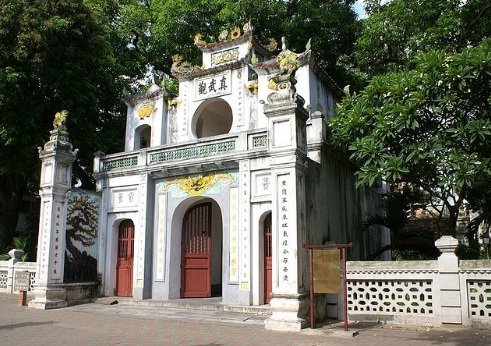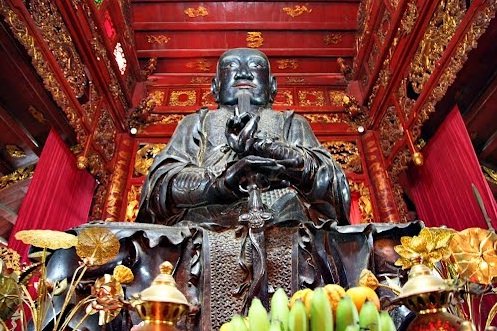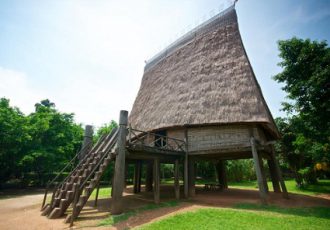
Is the Quan Thanh temple interesting?
For the oriental culture lovers, the art of FengShui is no longer something strange. But they may not know the highest level of this art, that is the FengShui of a city, of a country. In Hanoi, it is well known that there are 4 temples called The Sacred Quartet of Thang Long, where 4 gods are worshipped to protect and defend the city. The temples of Bach Ma, Thu Le, Kim Lien and Quan Thanh are located respectively to the east, west, south and north of our capital. It is dictated by legend that the gods Long Do, Linh Lang, Emperor Cao Son and Tran Vu protect the people of Hanoi from evil spirits, demons, monsters and even invaders.
A brief history
Let’s start with the Northern Temple, the Quan Thanh, also called the Tran Vu Temple which is located at the intersection of Thanh Nien Street and Quan Thanh Street, close to the West Lake and Truc Bach Lake. It worships Huyen Thien Tran Vu, a Taoist God who is also known as the Emperor of the North. The following legend explains the location of the temple:
Once upon a time, when monsters were still numerous and threatened the daily life of the people, in the West of Thang Long there was a houliking, a fox-woman, who ruled a very large territory and ate people. The people cried out to the Jade Emperor, and he asked God Huyen Thien to come down and kill the houliking, to help the people. The battle went on for days and nights, destroying everything around them. And when God Huyen Thien succeeded in chopping off the nine tails of the houliking, the earth collapsed into a giant hole, and its body fell into the hole. The Jade Emperor ordered the Rain God to fill in the hole, lest the humiking could one day resurrect itself. The hole thus became the Killed Fox Swamp, also known as the Western Lake. The Quan Thanh Temple was built near the lake to pay homage to the helpers of the God Huyen Thien.
Built in 1010 under the reign of King Ly Thai To, Quan Thanh Temple has been restored several times. In 1677, under the orders of King Le Hy Tong, the temple was restored for the first time. It was also in this year that the treasures of the temple were made: the statue of God Huyen Thien and the temple bell, both made of black bronze. In 1842, King Thieu Tri visited the temple and presented a sum of gold to make a gold bracelet and put it on the statue’s wrist. The other two major restorations were in 1856 and 1893.
The architecture
The Quan Thanh Temple is built according to Chinese architecture, consisting of 5 elements: the portico with 3 entrances, the courtyards and the 3 levels of the tien de _ trung de _ hau cung prayer place, of which the portico is the most architecturally remarkable structure.

What to see?
The portico is built in the shape of a đình “the communal house” of the Vietnamese. It consists of 1 floor and 3 entrances. In the eastern culture, especially in the feudal era, the three entrances with the largest one in the middle served for kings and their courtiers: kings could only enter through the one in the middle, consultants through the left and generals through the right. What is remarkable in the portico of the Quan Thanh temple is the relief of Rahu _ a Hindu demon who sometimes swallows the Sun or the Moon, causing eclipses. This relief is proof of the integration of the beliefs in Vietnam. Upstairs is the temple bell tower, which protects the star of the bells in Hanoi.
Before returning to the bell, we invite you to discover the main treasure of Quan Thanh Temple: the black bronze statue of Huyen Thien. Before 1677, it was made of wood, and during the first restoration, it was decided to recreate it in black bronze. The work was done manually by the craftsmen of Ngu Xa craft village. The statue is about 4m tall, weighs 4 tons, and is placed on a 1m high marble platform. Huyen Thien is depicted seated, wearing his Taoist clothes, with a square face; his expression severe but calm. He had bare feet, and his left hand was in mudrā _ exorcism position. One of the rituals known to visitors and believers who come to Quan Thanh Temple is to touch the feet of the statue in prayer. It is hoped that God Huyen Thien will bless them with strength and protect them from mental evils. He was leaning his sword with his right hand on the back of a turtle, and around the sword a snake was coiled. A statue of such finesse at this size, formed by hand some 350 years ago, is a proud testament to the excellence of Vietnamese craftsmanship.
Two other bronze pieces to visit at Quan Thanh Temple are the statue of Trum Trong, the master who designed the Marquette of the Huyen Thien statue, and the black bronze bell. The statue of Trum Trong was formed by his students after his death as a way of paying tribute to their teachers. The last of the pieces is the temple bell. It measures 1.5m, and weighs 1 ton. The sound of its singing was famous for being echoed in every corner of its region.
Quan Thanh Temple is not only a constituent of the Hanoi Sacred Quartet, but it remains one of the last Taoist temples in Vietnam. It demonstrates multiple cultural values of Hanoi and the country: the excellent level of Vietnamese craftsmanship in the 17th century, and the integration and personalization of people’s beliefs. It is undoubtedly one of the must-see tourist sites in Hanoi. We advise you not to choose the 1st and 15th of the lunar calendar so that you can better observe and admire the site. However, if you are interested in the cults and the practice of the Vietnamese cults, no other place could offer you better opportunities.



